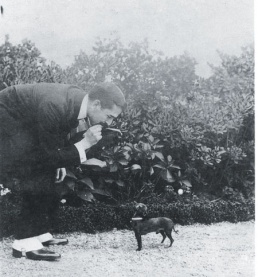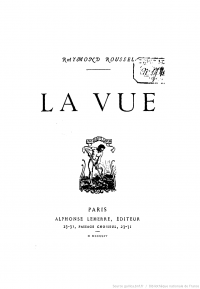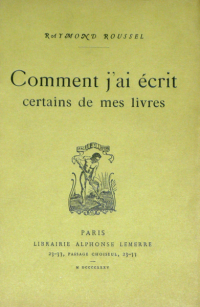Difference between revisions of "Raymond Roussel"
| Line 43: | Line 43: | ||
==Works== | ==Works== | ||
| + | [[Image:Roussel_Raymond_La_Doublure.png|thumb|200px|''La Doublure'', 1897, [http://gallica.bnf.fr/ark:/12148/bpt6k109251c BnF].]] | ||
| + | [[Image:Roussel_Raymond_Chiquenaude.jpg|thumb|200px|''Chiquenaude'', 1900, [http://fr.wikisource.org/wiki/Livre:Roussel_-_Chiquenaude,_1900.djvu WS].]] | ||
| + | [[Image:Roussel_Raymond_La_vue.png|thumb|200px|''La Vue'', 1904, [http://gallica.bnf.fr/ark:/12148/bpt6k108427z BnF], [http://fr.wikisource.org/wiki/Livre:Roussel_-_La_Vue,_1904.djvu WS].]] | ||
| + | [[Image:Roussel_Raymond_Impressions_d_Afrique.png|thumb|200px|''Impressions d'Afrique'', 1910, [http://gallica.bnf.fr/ark:/12148/bpt6k1092500 BnF].]] | ||
| + | [[Image:Roussel_Raymond_Locus_solus.png|thumb|200px|''Locus Solus'', 1914, [http://gallica.bnf.fr/ark:/12148/bpt6k109252r BnF], [http://fr.wikisource.org/wiki/Livre:Roussel_-_Locus_Solus,_1914.djvu WS], [[Media:Roussel_Raymond_Locus_Solus_1914.pdf|PDF]].]] | ||
| + | [[Image:Roussel_Raymond_L_Étoile_au_front.png|thumb|200px|''L'Étoile au front'', 1925.]] | ||
| + | [[Image:Roussel_Raymond_La_Poussiere_de_soleil.png|thumb|200px|''La Poussière de soleil'', 1927.]] | ||
| + | [[Image:Roussel_Raymond_Nouvelles_impressions_d_Afrique.jpg|thumb|200px|''Nouvelles impressions d'Afrique'', 1932, [http://gallica.bnf.fr/ark:/12148/bpt6k108582f BnF].]] | ||
| + | [[Image:Roussel_Raymond_Comment_j_ai_ecrit_certains_de_mes_livres.png|thumb|200px|''Comment j'ai écrit certains de mes livres'', 1935.]] | ||
* [http://gallica.bnf.fr/ark:/12148/bpt6k109251c ''La Doublure''], Paris: Alphonse Lemerre, 1897, [[Media:Roussel_Raymond_La_doublure_1897.pdf|PDF]], [http://fr.wikisource.org/wiki/Livre:Roussel_-_La_Doublure,_1897.djvu WS]; repr. in Roussel, ''Œuvres, I'', ed. Annie Le Brun, Paris: Pauvert/Fayard, 1994. A novel in verse. {{fr}} | * [http://gallica.bnf.fr/ark:/12148/bpt6k109251c ''La Doublure''], Paris: Alphonse Lemerre, 1897, [[Media:Roussel_Raymond_La_doublure_1897.pdf|PDF]], [http://fr.wikisource.org/wiki/Livre:Roussel_-_La_Doublure,_1897.djvu WS]; repr. in Roussel, ''Œuvres, I'', ed. Annie Le Brun, Paris: Pauvert/Fayard, 1994. A novel in verse. {{fr}} | ||
| Line 143: | Line 152: | ||
==Literature== | ==Literature== | ||
| − | [[Image:Foucault_Michel_Raymond_Roussel_French.jpg|thumb| | + | [[Image:Foucault_Michel_Raymond_Roussel_French.jpg|thumb|200px|Michel Foucault, ''Raymond Roussel'', 1963, [[Media:Foucault_Michel_Raymond_Roussel_French.pdf|PDF]], [http://monoskop.org/log/?p=6779 Log]. {{fr}}]] |
* Sterling Heilig, [[Media:Heilig_Sterling_1910_Yes_He_Really_Likes_to_Work.gif|"Yes He Really Likes to Work"]], ''Cleveland Plain Dealer'', 18 Dec 1910. {{en}} | * Sterling Heilig, [[Media:Heilig_Sterling_1910_Yes_He_Really_Likes_to_Work.gif|"Yes He Really Likes to Work"]], ''Cleveland Plain Dealer'', 18 Dec 1910. {{en}} | ||
Revision as of 09:55, 8 July 2015
 Roussel in Carlsbad, 1912. | |
| Born |
January 20, 1877 Paris, France |
|---|---|
| Died |
July 14, 1933 (aged 56) Palermo, Italy |
| Web | Aaaaarg, Wikipedia, Using "Academia.edu" as base chain is not permitted during the annotation process., Open Library |
Raymond Roussel (1877-1933) was a French poet, novelist, playwright, musician, and chess enthusiast. Through his works he exerted a profound influence on certain groups within 20th century French literature, including the Surrealists, Oulipo, and the authors of the nouveau roman.
Life, work and its reception
This section is sourced from Museo Reina Sofia exhibition dossier.
Raymond Roussel, the author of The View (1904) and Locus Solus (1913) occupies a unique place in literature, to which he dedicated his entire life and consecrated a large part of his fortune. In the ten works he brought out during his lifetime - poems or verse novels, tales or plays - he aimed at creating a world from scratch in which “imagination is everything”, and in which nothing real should impinge on the writing. Absorbed in this enterprise and convinced of his genius, he lived through the first third of the 20th century without paying any attention to its political upheavals or their aesthetic consequences among the various avant-garde movements, while failing to understand why the more conventional audience he thought he was addressing remained indifferent to his work, and found its stage adaptations scandalous.
Often described by his contemporaries as a haughty dandy, he did indeed spend most of his life retired from society, and though his “life was constructed like his books”, in the words of the psychiatrist Pierre Janet, he was in reality an enthusiastic character, whose worship of genius came firstly from his loyal attachment to his childhood memories and reading, and subsequently from his devotion to those whom he considered to be great minds: Jules Verne and Pierre Loti with their real or imaginary travels, the astronomer Camille Flammarion or the poet Victor Hugo. However, he remained distinct from the last two on this list because of his refusal of anything supernatural, which he replaced by the absolute value of invention, set in a theatrical universe constructed by a chain of enigmas, the solutions of which were always impeccably logical. It was above to channel his overpowering imagination that Roussel conceived some of his works using a “highly special procedure”, which he was to reveal only in his literary testament published after his death: How I Wrote Certain of My Books. This procedure, “related to rhyme”, is based on combinations of homophones and the association of words with double meanings. It is the distance between these terms, placed invariably at the beginning and end of each story, that would later provide Roussel with a framework for his writing as well as an inexhaustible store of unexpected images and stories, such as the “statue of whalebones” or the “worm playing a cithara”, in his Impressions of Africa.
The posthumous revelation of Roussel’s writing procedure has lastingly influenced his reception, and as a result many critics have often considered him, wrongly, to be a mere manipulator of words, thus confirming the thesis that his was a modern form of writing, based only on self-referentiality and arbitrary constraint.
Even if he was only to become aware of the fact late in his life, during his lifetime Roussel attracted a great deal of enthusiasm among a generation of artists and poets. It was one of the performances of Impressions of Africa in 1912 that Marcel Duchamp, who was there with Guillaume Apollinaire and Francis Picabia, was to recall and mention as a primary influence on his Large Glass. The photographic precision and laconicism of Roussel’s writing, his taste for technical and scientific innovations, as well as the absence of any psychological depth in his characters, who come over as simple puppets lacking in depth, come together to make Roussel one of the sources of the “bachelor machines”, as the writer Michel Carrouges pointed out in 1954.
Marcel Duchamp seems to have made Roussel’s name known to the Parisian Dadaists, who were to discover him during performances of Locus Solus in 1922. Philippe Soupault, Paul Eluard and Roger Vitrac then took up his defence in Dada and then Surrealist reviews, seeing him as an equivalent of Douanier Rousseau, or comparing the park in Locus Solus to the deserted esplanades of Giorgio de Chirico. A “Rousselian” cult then progressively took form: ‘the President of the Republic of Dreams” (Louis Aragon), “the greatest mesmerist of modern times” (André Breton), “his eye glued to his microscope” (Robert Desnos), Roussel was, for the Surrealists, the person who engineered “the escape from the world of reality into that of conception” (Michel Leiris). Leiris was linked to Roussel though his father, who was the Roussel family’s business manager, and he closely associated his passion for the author with his own work as an ethnologist, placing under the auspices of Impressions of Africa his first ethnographical expedition to Dakar-Djibouti in 1931-1932, which was partly financed by Roussel, and which was directed by Marcel Griaule. In the pages of Georges Bataille’s review, Documents, Leiris hailed the depiction in Impressions of an Africa that was so marvellous that its exoticism owed nothing to the colonial stereotypes of the time.
Reading Roussel was also fundamental to the creation of Salvador Dali’s paranoiac-critical theory during the 1930s. To Roussel’s doubling of words, Dali answered with a doubling of images; and it was the crystal transparency of Roussel’s texts, in particular his poem "The View", that provided Dali with a model for his “rigurosa lógica de la Fantasía”, confirming the necessary exactitude of the imagination, thus giving rise to visions that materialise subconscious desires as closely as possible.
In an article published in the review Le Surréalisme au service de la Révolution, in 1933, a few months before Roussel’s death, Dali paid homage to the “ungraspable” character of New Impressions of Africa, his last published poem, which he had worked on for ten years. In this text, Roussel sacrificed the transparency of his writing for a principle of permanent digression. Practically every word of the poem is a pretext for an analogy or comparison, while opening a breach in the text from which then surges a series of commentaries, judged to be “impenetrable” by Dali. Roussel’s insistence on concision forced him to increase the number of ellipses as his text swelled with digressions. Probably with a view to finding a system that would simplify reading it, and point to an order in the intertwining of narrative threads, Roussel opted for a typographical device, cutting up his text with brackets nestled in layers. Along with the mysterious illustrations, which Roussel ordered from the conventional painter Henri Zo, New Impressions stands as a complex book-object which was to inspire several “reading machines”.
The reception of Roussel after the Second World War was essentially the work of the Collège de ‘Pataphysique, founded in Paris in 1948 to celebrate the fiftieth anniversary of the publication of Alfred Jarry’s Docteur Faustroll. Thanks to the publications of the Transcendant satrape Jean Ferry, who set about an erudite, literal deciphering of Roussel, without attempting to interpret him, and the “Machine for reading Roussel” (1954) by the Argentinian artist Juan Esteban Fassio, the trend was now to adhere literally to Roussel’s texts and provide them with illustrations. It was for the Collège that Jacques Carelman produced, on the invitation of Harald Szeemann, two sculptures based on descriptions in Locus Solus for the Bachelor Machines exhibition (1976), while Jean-Christophe Averty was to conceive a televised version of Impressions of Africa (1977).
Since the 1960s, Roussel’s oeuvre has been widely translated, especially in the United States thanks to the poet John Ashbery who, after carrying research in Paris during the 1950s into the author of Locus Solus, founded a review of the same name with, among others, Harry Mathews, who wrote a brilliant Rousselian pastiche with Georges Perec in 1977. The influence of the review Locus Solus, which was little noticed at the time, nevertheless brought Raymond Roussel’s name to the poets of the New York School. Meanwhile, the writings of Michel Foucault, Michel Butor and Alain Robbe-Grillet were the source of interest in Roussel among numerous artists, including Vito Acconci, and in the 1980s in Los Angeles, Allen Ruppersberg, Morgan Fischer and Mike Kelley, centred around the recently rediscovered work of the French artist Guy de Cointet.
Readings and interpretations of Roussel have changed enormously over the past century, and the figure of this writer, who throughout his life guarded against revealing the slightest information about himself and kept an air of mystery around the genesis of his works, has become an essential model of the artist, standing as the Minotaur at the centre of the labyrinth of his work. At the end of the 1980s, the discovery of a considerable stock of archives and manuscripts, many of them unpublished, now conserved at the Bibliothèque Nationale de France, has shed new light on his oeuvre, confirming Michel Leiris’s view that “no one has ever touched so closely the mysterious influences that govern the lives of men.
Works


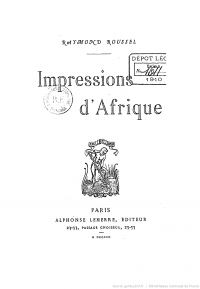
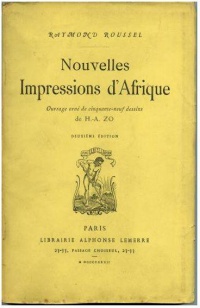
- La Doublure, Paris: Alphonse Lemerre, 1897, PDF, WS; repr. in Roussel, Œuvres, I, ed. Annie Le Brun, Paris: Pauvert/Fayard, 1994. A novel in verse. (French)
- "Mon âme", Le Gaulois, 12 Jul 1897; repr. in Roussel, Œuvres, I, ed. Annie Le Brun, Paris: Pauvert/Fayard, 1994. A poem. (French)
- Chiquenaude, Paris: Alphonse Lemerre, 1900; repr. in Roussel, Œuvres, ed. Danielle Chaperon, Paris: Pauvert/Fayard, 2007. A novel. (French)
- Chiquenaude und andere Texte aus früher Jugend, trans. Maximilian Gilleßen, Berlin: Zero Sharp, 2014, 109 pp. (German)
- "La Seine" [1900], in Roussel, Œuvres, III, ed. & pref. Patrick Besnier, Paris: Pauvert/Fayard, 1994. A novel in verse. (French)
- "Les Noces", in Roussel, Œuvres, V, ed. Pierre Bazantay, pref. Annie Le Brun, Paris: Pauvert/Fayard, 1998. A novel in verse, unfinished. (French)
- "La Vue", Le Gaulois du dimanche, 18-19 Apr 1903; repr. as La Vue, Paris: Alphonse Lemerre, 1904, WS; repr. in Roussel, Œuvres, IV, ed. Patrick Besnier, Paris: Pauvert/Fayard, 1998. A poem. 1904 edition also contains the poems "Le Concert" (Le Gaulois du dimanche, 27-28 Jun 1903) and "La Source". (French)
- "L'Inconsolable", Le Gaulois du dimanche, 10-11 Sep 1904. (French)
- "Têtes de carton du carnaval de Nice", Le Gaulois du dimanche, 26-27 Sep 1904. (French)
- "Nanon", Le Gaulois du dimanche, 14-15 Sep 1907; repr. in Roussel, Œuvres, ed. Danielle Chaperon, Paris: Pauvert/Fayard, 2007. (French)
- "Une Page du folk-lore breton", Le Gaulois du dimanche, 6-7 Jun 1908; repr. in Roussel, Œuvres, ed. Danielle Chaperon, Paris: Pauvert/Fayard, 2007. (French)
- "Impressions d'Afrique", Le Gaulois du dimanche, 10 Jul & 20 Nov 1909; repr. as Impressions d'Afrique, Paris: Alphonse Lemerre, 1910, WS; Paris: Jean-Jacques Pauvert, 1979, 316 pp; Paris: Le Livre de poche, 1991, 349 pp; new ed., intro. & notes Tiphaine Samoyault, Paris: Garnier-Flammarion, 2005, 377 pp. [1] (French)
- Impressioni d'Africa, Milan: Rizzoli, 1964, 271 pp; repr., intro. John Ashbery, Milan: Rizzoli, 1982, xix+267 pp. (Italian)
- "Wrażenia z Afryki", Cezar Rowiński, Literatura na Świecie 41:9 (1979). Trans. of fragment. (Polish)
- Eindrücke aus Afrika, trans. Cajetan Freund, illustr. Markus Raetz, afterw. Bernd Mattheus, Munich: Matthes und Seitz, 1980, 303 pp. (German)
- Impresiones de Africa, trans. Teresa Gallego and Isabel Reverte, Madrid: Siruela, 1990, xxxi+344 pp. Incl. "Cómo escribí algunos libros míos". (Spanish)
- Impressions d'Àfrica, trans. Annie Bats and Ramon Lladó, Barcelona: Edicions 62, 1992, 254 pp. (Catalan)
- "Indrukken van Afrika", in Roussel, Indrukken van Afrika / Nieuwe indrukken van Afrika, Amsterdam: Van Oorschot, 1996. (Dutch)
- Afurika no inshō [アフリカの印象], trans. Kōji Okaya, 白水社, 2001, 347 pp. (Japanese)
- Africké dojmy, trans. Miroslav Drozd, Prague: Dauphin, 2009, 394 pp. (Czech)
- Impressions of Africa, trans. & intro. Mark Polizzotti, Dalkey Archive Press, 2011, 280 pp. (English)
- Impressions of Africa, trans. Rayner Heppenstall and Lindy Foord, Richmond: Alma Classics, 2012, 224 pp. (English)
- "Quelques heures à Bougival", Le Gaulois du dimanche, 6 Dec 1913 & 28 Mar 1914; repr. as Locus Solus, Paris: Alphonse Lemerre, 1914, PDF, WS; Paris: Gallimard, 1963, 320 pp; Paris: Jean-Jacques Pauvert, 1977, 300 pp; Paris: Gallimard, 1990, 268 pp; Paris: Garnier-Flammarion, 2005, 334 pp. A novel. [2] (French)
- Locus Solus, trans. & afterw. Olivier de Magny, Berlin: Hermann Luchterhand, 1968, 468 pp. (German)
- Locus Solus, trans. Rupert Copeland Cuningham, London: Calder & Boyars, 1970; repr., Richmond: Oneworld Classics, 2008. [3] (English) Review: Dan Visel.
- Locus solus, trans. José Escué and Juan Alberto Ollé, Barcelona: Seix Barral, 1970, 305 pp. (Spanish)
- "Locus solus", in Roussel, Locus solus; seguito da, Come ho scritto alcuni miei libri, trans. V. Riva, ed. Paola Dècina Lombari, Torino: Einaudi, 1975. (Italian)
- Locus Solus, trans. Anna Wolicka, intro. Cezary Rowiński, Warsaw: Państ. Instytut Wydawn., 1979, 291 pp. (Polish)
- Locus Solus, trans. Cajetan Freund, 2nd ed., Frankfurt/M: Suhrkamp, 1983. (German)
- Locus Solus, trans. & afterw. Torsten Ekbom, Stockholm: Författarförl., 1989, 293 pp. (Swedish)
- Locus Solus, trans. & afterw. Marij Elias, Amsterdam: Perdu, 1993, 351 pp. (Dutch)
- Locus solus, trans. Tahsin Yücel, Istanbul: Yapı Kredi Yayınları, 1994, 204 pp. (Turkish)
- Locus Solus, trans. Miroslav Drozd, Prague: Dauphin, 2002, 205 pp. (Czech)
- Rokusu sorusu [ロクス・ソルス ], trans. Okaya Kōji, Tokyo: Heibonsha, 2004, 387 pp. (Japanese)
- Locus Solus, trans. Lars Vissing, Copenhagen: Gyldendal, 2008, 273 pp. (Danish)
- Locus Solus, trans. Marcelo Cohen, Madrid: Capitán Swing, 2011. (Spanish)
- Locus Solus. In der Druckfassung von 1914 und ergänzt durch Episoden aus der erstmals veröffentlichten Urfassung, trans. & comm. Stefan Zweifel, Berlin: Die andere Bibliothek, 2012, 487 pp. (German)
- Locus solus, trans. Joaquim Sala-Sanahuja, Palma, Mallorca: Lleonard Muntaner, 2012, 263 pp. (Catalan)
- Locus solus, trans. Isabel Soto and Xavier Senín, Santiago de Compostela Hugin e Munin, 2012, 292 pp. (Galician)
- Locus solus, trans. Jorge Segovia, Maldoror, 2013. (Spanish)
- L'Allée aux lucioles [1914], Presses du Réel, 2008; repr. in Roussel, Œuvres, IX, eds. Annie Le Brun and Patrick Besnier, Paris: Pauvert/Fayard, 2009. A novel begun in 1914 and unfinished. (French)
- "Flio" [1914], ed. Michel Leiris, Bizarre, 1964, pp 2-13; repr. in Roussel, Œuvres, IX, eds. Annie Le Brun and Patrick Besnier, Paris: Pauvert/Fayard, 2009. (French)
- Flio, trans. Damián Tabarovsky, El Malentendido, 2003, 46 pp. (Spanish)
- Pages choisies d'Impressions d'Afrique et de Locus Solus, Paris: Alphonse Lemerre, 1918; repr. in Roussel, Œuvres, IX, eds. Annie Le Brun and Patrick Besnier, Paris: Pauvert/Fayard, 2009. (French)
- L'Étoile au front, Paris: Alphonse Lemerre, 1925; Paris: Jean-Jacques Pauvert, 1963, 230 pp. A play. [4] (French)
- Der Stern auf der Stirn. Stück in 3 Akten, trans. Klaus Völker, Frankfurt am Main: Verlag der Autoren, 1974, 96 pp; repr. as "Der Stern auf der Stirn", in Roussel, Die Prädestinierten. 2 Theaterstücke, ed. Klaus Völker, Munich: Hanser, 1978. (German)
- Hitai no hoshi; Musū no taiyō [額の星], 2001, 384 pp. (Japanese)
- La Poussière de soleil, Paris: Alphonse Lemerre, 1927; Paris: Jean-Jacques Pauvert, 1964, 200 pp. A play. [5] (French)
- "Sonnenstaub", in Roussel, Die Prädestinierten. 2 Theaterstücke, ed. Klaus Völker, Munich: Hanser, 1978. (German)
- "Słoneczny pył", trans. Maryna Ochab, Literatura na Świecie, 9-10 (1997), pp 31-177. [6] (Polish)
- The Dust of Suns, trans. Harry Mathews, intro. Alastair Brotchie, illustr. Numa and Chazot, London: Atlas Press, 2011, 160 pp. [7] (English)
- Nouvelles impressions d'Afrique, Paris: Alphonse Lemerre, 1932. A poem of four cantos with 59 drawings by Henri-A. Zo; incl. L'Âme de Victor Hugo. (French)
- Nouvelles impressions d'Afrique. Französisch/deutsch, trans. & ed. Hanns Grössel, Munich: Text und Kritik, 1980, 137 pp. (French)/(German)
- Novas impressões de África, trans. Luiza Neto Jorge, intro. Manuel João Gomes, Lisbon: Fenda, 1988, 137 pp. (Portuguese)
- "Nieuwe indrukken van Afrika", in Roussel, Indrukken van Afrika / Nieuwe indrukken van Afrika, Amsterdam: Van Oorschot, 1996. (Dutch)
- New Impressions of Africa, trans. & intro. Ian Monk, London: Atlas Press, 2004, 256 pp. [8] (French)/(English) Review: James Elkins.
- New Impressions of Africa / Nouvelles Impressions d’Afrique, trans., intro. & notes Mark Ford, Princeton University Press, 2011, 260 pp. (French)/(English)
- Noves impressions d'Africa, trans. Jordi Vintró, Barcelona: Labreu, 2014, 360 pp. (Catalan)
- Comment j'ai écrit certains de mes livres, Paris: Alphonse Lemerre, 1935. (French)
- Como escribí algunos libros mios, intro. Michel Foucault, Barcelona: Tusquets, 1973, 66 pp. (Spanish)
- "Come ho scritto alcuni miei libri", in Roussel, Locus solus; seguito da, Come ho scritto alcuni miei libri, ed. Paola Dècina Lombari, Torino: Einaudi, 1975. (Italian)
- "Wie ich einige meiner Bücher geschrieben habe", in Raymond Roussel: ein Dokumentation, ed. Hanns Grössel, Munich: Text und Kritik, 1977. (German)
- How I Wrote Certain of my Books, trans. Trevor Winkfield, Exact Change, 1995, 288 pp. (English) Contains a cross-section of his major writings, including Roussel's essay on how he composed his books, the first chapter of each of Impressions d'Afrique and Locus Solus, the fifth act of a play, the third canto of New Impressions of Africa and all 59 of its drawings, and the outline for a novel Roussel apparently never wrote.
- "Kuinka olen kirjoittanut eräitä kirjoistani", trans. Olli Sinivaara, Nuori Voima 6 (2004), pp 9-16. (Finnish)
- Indications pour 59 dessins, Cahiers GLM, Mar 1939. (French)
- Parmi les noirs, 1935. (French)
- "Unter den Schwarzen", in Raymond Roussel: ein Dokumentation, ed. Hanns Grössel, Munich: Text und Kritik, 1977. (German)
- Among the Blacks: Two Works, 1988. (English)
- "À la Havane", l'Arc 19, Aix-en-Provence, 1962, pp 37-47. (French)
- In Havanna: als Kanevas gedachte Dokumente. Ein Romanfragment, ed., trans. & foreword Hanns Grössel, Frankfurt am Main: Qumran, 1982, 101 pp; Frankfurt am Main: Syndikat/EVA, 1984, 101 pp. (German)
- "W Hawanie i Dokumenty mające służyć za kanwę", trans. Andrzej Sosnowski, Literatura na Świecie, 9-10 (1997), pp 319-326. [9] (Polish)
- Dokumenty mające służyć za kanwę, trans. Andrzej Sosnowski, Wrocław: Biuro Literackie, 2008, 73 pp. (Polish)
- Épaves (1911-1932), À la Havane, Damiette, Paris: Pauvert, 1972. (French)
- Teatro, intro. & trans. Brunella Schisa, Torino: Einaudi, 1982, xvii+208 pp. (Italian)
- Œuvres, 9 vols., ed. Annie Le Brun, et al., Paris: Pauvert/Fayard, 1994-2009. [10] (French)
- Œuvres théâtrales, eds. Annie Le Brun and Patrick Besnier, Paris: Jean-Jacques Pauvert, 2013, 856 pp. (French)
Literature
- Sterling Heilig, "Yes He Really Likes to Work", Cleveland Plain Dealer, 18 Dec 1910. (English)
- Michel Foucault, Raymond Roussel, Paris: Gallimard, May 1963, 212 pp. (French)
- Raymond Roussel, trans. Patricio Canto, Buenos Aires: Siglo XXI, 1973; 1976, ARG. (Spanish)
- "Schwelle und Schlüssel", trans. Hanns Grössel, in Raymond Roussel. Eine Dokumentation, ed. Hanns Grössel, Munich, 1977, pp 122-131. (German)
- Raymond Roussel, Bologna: Cappelli, 1978, 175 pp; ed. & intro. Massimiliano Guareschi, Verona: Ombre corte, 2001, 188 pp. (Italian)
- Death and the Labyrinth: the World of Raymond Roussel, trans. Charles Ruas, Athlone, 1987, 186 pp; Continuum, 2007, 227 pp, ARG. (English) Review: John Sturrock.
- Raymond Roussel, trans. Renate Hörisch-Helligrath, Frankfurt am Main, 1989. (German)
- Raymond Roussel, trans. Manoel Barros da Motta and Vera Lúcia Avellar Ribeiro, Rio de Janeiro: Forense Universitária, 1999. (Brazilian Portuguese)
- Rēmon Rūseru [レーモン・ルーセル], trans. Toyosaki Koichi (豊崎光一), Hōseidaigaku shuppan-kyoku (法政大学出版局), 2000. (Japanese)
- Raymond Roussel, trans. Grzegorz Wilczyński, Warsaw: KR, 2001. (Polish)
- Raymond Roussel, trans. Josef Fulka, Herrmann & synové, 2006, 203 pp. (Czech)
- Raymond Roussel: Ölüm ve Labirent, trans. Savaş Kılıç, Koç Üniversitesi, 2013, 162 pp. (Turkish)
- Hanns Grössel (ed.), Raymond Roussel: ein Dokumentation, Munich: Text und Kritik, 1977, 176 pp. [11] (German)
- Alastair Brotchie, Andrew Thompson (eds.), Raymond Roussel: Life, Death and Works, London: Atlas Press, 1987, 157 pp. [12] (English) Review: John Sturrock.
- François Caradec, Raymond Roussel, Paris: Fayard, 1997. A biography. (French)
- Raymond Roussel, trans. Ian Monk, London: Atlas Press, 2001, 368 pp. [13] (English)
- Michel Leiris, Roussel l’ingénu, Fata Morgana, 1987; repr. in Roussel & Co, 1998. Seven articles on Raymond Roussel from 1935-86. (French)
- Michel Leiris, Roussel & Co., eds. Jean Jamin and Annie Le Brun, Fata Morgana & Fayard, 1998. Contains Roussel l’ingénu (1987), correspondence with Roussel and a selection of texts. (French)
- Mark Ford, Raymond Roussel and the Republic of Dreams, foreword John Ashbery, Cornell University Press, 2000, 239 pp. A biography. (English) Reviews. [14]
- "Première journée, après-midi. Raymond Roussel", ed. M. Sjef Houppermans, Cahiers de l'Association internationale des études francaises 56 (2004). (French)
- John Tresch, "In a solitary place. Raymond Roussel's brain and the French cult of unreason", Studies in History and Philosophy of Biological and Biomedical Sciences 35 (2004), pp 307-332. (English)
- Locus Solus. Impressions de Raymond Roussel, ed. Turner/Museo Reina Sofía, Madrid: Museo Reina Sofía, 2011, 308 pp. Exh. catalogue. [15]
- Caitlin Murray, "How to Isolate the Infrathin: Marcel Duchamp, Raymond Roussel and the Infrathin", c2013. (English)
Links
- Locus Solus: Impressions of Raymond Roussel, an exhibition at Reina Sofia, Madrid, 2011-12.
- Nouvelles impressions de Raymond Roussel, an exhibition at Palais de Tokyo, Paris, 2013. Review: Joseph Nechvatal.

